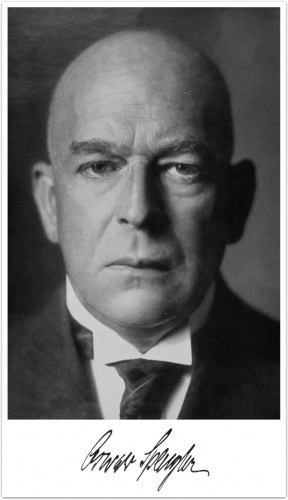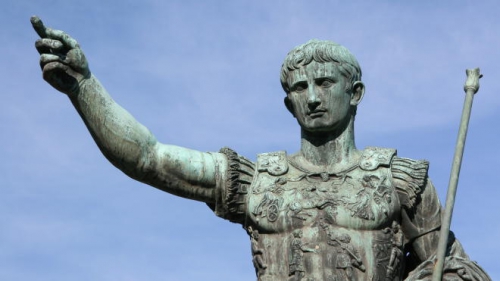There has long been a commonplace notion in journalism (now often repeated in blogs and social media), that Oswald Spengler declared us to be at the end of Civilization. After all, he did write The Decline of the West, didn’t he? Furthermore, Spengler’s end-phase of Civilization is Caesarism, and we passed that many decades ago—so the story goes—during the age of Musso & Dolf.
This is all nonsense, of course. It comes as no surprise that this misrepresentation took hold during the 1930s and early 1940s, when Spengler came to be recast as a kind of prophet for National Socialist Germany. But before getting to that, let me just point out that the “Caesarism” bit is easily disproven. You need only consult the fold-out endpaper charts of “Historical Morphology” in The Decline of the West to set the facts straight.
I reproduce a portion of the relevant ‘Contemporary “Political” Epochs’ table at the bottom of this essay for reference, but the essential takeaway is this: Spengler’s “Winter” epoch, when Civilization finally supplants Culture, begins with the age of Napoleon around 1800 and moves on through two centuries of Imperialism and Wars of Annihilation. After 2000 comes the period of Caesarism, which reaches final maturity, and decay, after 2200.[1]
 According to this matrix, our Caesarism period of 2000-2200 corresponds to 100 BC – 100 AD in Classical civilization. The post-2200 era corresponds to the Roman Empire from Trajan onwards. Here civilization has attained its peak, while cultural forms are completed, calcified, past evolution. This, you might say, is the true End of History—for our Western, Faustian civilization at least. But we have a way to go.
According to this matrix, our Caesarism period of 2000-2200 corresponds to 100 BC – 100 AD in Classical civilization. The post-2200 era corresponds to the Roman Empire from Trajan onwards. Here civilization has attained its peak, while cultural forms are completed, calcified, past evolution. This, you might say, is the true End of History—for our Western, Faustian civilization at least. But we have a way to go.
Now, one can dismiss Spengler’s schema as hogwash, the way one might reject astrology or Kondratieff waves; but one should at least know Spengler’s timeline before declaring an opinion on it. Just as one should bear in mind that in presenting his theory of the morphology of history, Spengler uses convenient analogies, e.g., the cultural epochs of Spring, Summer, Autumn, Winter. When he says the great cultures are organic—they mature, bloom, and decay—he does not literally mean they are flowers. Yet these metaphors have always been a sore point with his critics. [2]
Getting back to Caesarism, let’s accept Spengler’s thesis arguendo and look at its significance. Caesarism marks the end of “Democracy,” brings “Victory of force politics over money” (chart at bottom). Economic powers give way to an authoritarian model that promotes collective values of health and social justice—or to use Spengler’s own description, “Ethical socialism after 2000” (Table I, Contemporary “Spiritual” Epochs—not reproduced here).
Breaking the money-power and promoting the national welfare was of course what the European nationalist governments of the 1920s and 1930s imagined they were doing, or intended to do. Spengler himself rejected the association of ‘Caesarism’ with National Socialism (The Hour of Decision). But it is easy to see how journalists—or Nazis—might confuse the two.
To Spengler, Caesarism isn’t a good thing or a bad thing, it just is. But his description of the epoch in Roman times is bleak. This truly was the end of that culture’s growth-and-struggle:
There are no more of those great decisions which concentrate the inner meaning of the whole culture . . . All great political questions are solved, as they are solved sooner or later in every civilization, inasmuch as questions are no longer felt as questions and are not asked . . .
. . . The struggle for the Caesar-title became steadily more and more negroid, and might have gone on century after century in increasingly primitive and, therefore, eternal” forms.
These populations no longer possessed a soul. Consequently they could no longer have a history proper to themselves. At best they might acquire some significance as an object in the history of an alien Culture and whatever deeper meaning this relation possessed would be derived entirely from the will of the alien Life. (Vol .2, pp. 50-51)
The “alien Life” Spengler has in mind here is of course our own culture and civilization, what he called Western or Faustian-Gothic. The solons of the Renaissance and Enlightenment might have liked to imagine otherwise, but there is no real continuity between the civilization of Greece and Rome and our own; we merely treasure their artifacts as museum-pieces.
Confusion about Caesarism, and Spengler’s schema in general, has been around a long while. But it was apparently not there in the 1920s when thoughtful people read Decline for the first time. That cynosure of high-middlebrow discernment, Time magazine, treated it appreciatively, almost worshipfully, when it reviewed Vols 1 and 2 in 1926 and 1928.
Hard to improve upon is Time’s deft précis of the complete work, noting that Spengler
. . . analyzes history by huge analogies. Civilizations he sees as emerging & disappearing in cycles, each one, like a flower, experiencing birth, growth, decay, death. Our own Western civilization he declares to be in the phase of decay, characterized by material expansion, effete spirituality. Collapse is imminent in perhaps 300 years. But by that time another human group will be unwittingly generating a new civilization to flourish and sink in its own long turn. Herein lies the refutation of the charge of pessimism applied to Spengler by lesser minds. Regarding civilizations as organisms, he is no more the pessimist than any man who recognizes the transient nature of all organic life.[3]
This would be the high point of Spengler’s international reputation. A polymath and popular philosopher with a special appeal to autodidacts, Spengler was inevitably ground down by other, more specialized critics. Scholars in every field nit-picked his assertions and called him an amateur, a dilettante, a shoddy researcher. (A mere Gymnasium teacher, moreover.) Writing in The Spectator in 1929, an English reviewer lambasted Spengler’s whole conception of history as a “top-heavy tower,” a house of cards built upon factual inaccuracies and murky reasoning. Spengler’s description of the coming Caesarism came in for particular criticism as obscurantist wish-fulfillment.[4]
 Anyway, when Time reviewed Man and Technics a few years later, the bloom was off the rose. In an about-face from 1926, Time now declared Spengler a pessimist, one who thinks Civilization is done for. This time around, the reviewer dismissed his work with lip-smacking sarcasm:
Anyway, when Time reviewed Man and Technics a few years later, the bloom was off the rose. In an about-face from 1926, Time now declared Spengler a pessimist, one who thinks Civilization is done for. This time around, the reviewer dismissed his work with lip-smacking sarcasm:
To ward off suicidal despair Spengler recommends the psychological attitude of the Roman soldier who died at his post in Pompeii. When the volcano under civilization explodes, and the burning dust begins to descend, the more honorable Spenglerian carnivores will take it standing, polish up their buttons as the lava rises. [5]
The height of anti-Spenglerism came about ten years later. At the height of World War II, Foreign Affairs ran a 25-year retrospective of Decline of the West and found it all nail-bitingly depraved. 1942 was of course the height of the Second World War, thus this essay by Georgetown diplomatic historian Hans W. Wiegert can be regarded as a sort of stuffy, highbrow equivalent of Der Fuehrer’s Face.
Since Spenglerism is a flame which burns and can cripple souls, we are justified in reexamining it twenty-five years later. Indeed, we have a duty to do so. [6]
Wiegert demonizes Spengler’s masterwork as pure proto-Nazi propaganda on a par with Karl Haushofer. Decline is so tendentious that although Spengler pretends to be writing about the West (Abendland), he’s really describing an aggressive, expansive Germany:
The realm which he calls the West is not the West as we understand it. It is limited distinctly to Germany, and not even the whole of Germany, but only those parts of it which can be labeled (spiritually rather than geographically) the Germanic North. England and America, even France and Italy, are not within the boundaries of the West which he covers in his factual materials and comparisons.
* * *
The present writer believes that the human area which Spengler calls the Faustian-Nordic-German sphere, and whence he drew the factual foundations of his doctrine, is the only one where a Spenglerian conception of a human type fits—the type, that is, which gave up its freedom to become an earth-bound slave of Hitlerism.[7]
Wiegert spends several pages musing over the interplay of Spengler’s Caesarism forecasts and the rise of Hitler. At no point does he ever admit that Hitler just doesn’t fit into Spengler’s Caesar-time-scheme. He doesn’t care. Spengler sounded the drumbeat for Caesarism, incited the crowds. Thus he bears the weight of guilt for Nazism.
Spengler’s conception of Caesarism foreshadowed the growth of the totalitarian religions of our time. He translated Plato’s ideas on the relationship of tyranny and democracy into the language of the twentieth century. The dictatorship of money had used democracy as its political weapon. At the end of the First World War Spengler saw the doom of this money-power age. New forces, the forces of Caesarism, of which the multitude becomes willingly the passive object, were arising from the soil of democracy. The scene was set for the final battle between the forces of financial plutocracy and the purely political will-to-order of the Caesars.
* * *
Those Caesars who would rule the world when all the creative forces of culture had disappeared would be war-keen men. The appearance of one, Spengler wrote in 1917, would suddenly raise a powerless nation to the very peak, and his death would plunge a mighty nation into chaos. “They are for war, and they want war,” he added. “Within two generations it will be they whose will prevails.”[8]
For Wiegert, Hitler is plain-and-simple part of the Caesarian drama. He tops off his analysis with the suggestion that Hitler himself will succumb a military coup. (“The great drama of German Caesarism: the fall of the tyrant and the rise of army rule.”[9])
Wiegert seems to be suggesting an officers’ revolt along the lines of what became the failed coup of July 1944. But that’s really beside the point here, because he is trying to shoehorn the Hitler situation into Spenglerian Caesarism, and it just doesn’t fit.
Notes
1. This is taken from the combined one-volume 1928 edition of The Decline of the West, published by Alfred Knopf, translated by C. F. Atkinson. In the original two-volume format published in 1926 and 27, the tables appear at the end of Volume One, subtitled “Form and Actuality.”
2. See for example the C.E.M. Joad review in The Spectator, quoted below. (And not to belabor the point, but I have found that Spengler’s metaphors are very hard for some people to wrap their heads around. Decades ago I gave Yockey’s Imperium to a co-worker, thinking he’d enjoy it. And he did, but found the Spenglerian conceits ridiculous because “Culture isn’t really a living organism.” It is as though I showed him a chair for the first time and referred to its legs, and he said: “But those aren’t really legs! Those are just pieces of wood!” Maybe we’re all autistes when encountering the unfamiliar.)
3. Time, June 28, 1926.
4. “A Top-heavy Tower”, C.E.M. Joad, The Spectator, 12 January 1929.
5. Time, Feb. 29, 1932
6. Hans W. Wiegert, “Spengler Twenty-Five Years After,” Foreign Affairs, Oct. 1942.
7, 8, 9. Ibid.





 del.icio.us
del.icio.us
 Digg
Digg
Les commentaires sont fermés.